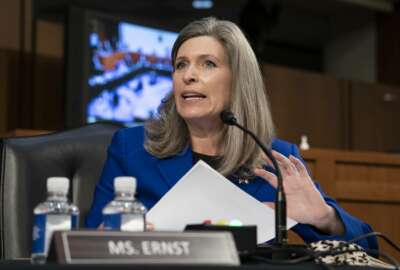USPS seeks higher borrowing limit from Treasury in 10-year plan update
USPS says these reforms are needed to continue with its network modernization plans.
The Postal Service, more than three years into a 10-year reform plan, is seeking a higher borrowing limit with the Treasury Department to sustain its infrastructure upgrades.
USPS, in an update to its “Delivering for America” plan last week, said its current $15 billion debt limit with Treasury was set in the 1970s, and has not been adjusted for inflation in decades.
“We continue to lack access to capital and credit markets that most in the private sector rely on in transformative situations like ours,” USPS wrote in a report last week.
USPS is also calling on the Office of Personnel Management to reassess what it pays into the Civil Service Retirement System, the pension system for federal employees who began government service before 1987.
Postmaster General Louis DeJoy and Roman Martinez IV, chairman of the agency’s Board of Governors, say these are just a few of the reforms USPS will need to keep up a “long overdue transformation” of its operations and achieve long-term financial stability.
“We also recognize that we are limited in what we can accomplish alone,” DeJoy and Martinez wrote. “We continue to seek congressional action to improve the financial, business, and oversight model that currently constrains the Postal Service.”
The Office of Personnel Management is responsible for administering CSRS benefits for USPS employees, and calculates what USPS must contribute every year to cover retiree health benefits for current employees.
USPS, its inspector general’s office and the National Association of Letter Carriers claim the agency has overpaid into the CSRS fund.
In addition, USPS is looking for great flexibility in its pension investment options. USPS, by law, can only invest its retiree and pension funds in low-risk, low-reward Treasury bonds.
But a report last year from the inspector general’s office found that if USPS invested those funds in a portfolio of 60% stocks and 40% bonds, its financial situation would improve dramatically.
USPS says these reforms are needed to continue with its network modernization plans.
The agency, so far, has committed more than $17 billion in capital investments — including more than $6 billion in existing facilities, “which were dilapidated after years of neglect and lack of investment.”
USPS says its network modernization plans are badly needed to revitalize legacy infrastructure, which was built to primarily transport letters and has been largely unchanged for decades.
However, the agency is putting some of its network modernization changes on hold until at least January 2025, at the request of a bipartisan group of House and Senate lawmakers.
USPS reiterated in its latest report that it will not close any of its 31,000 customer-facing retail locations, or reduce hours at post offices, as part of its network modernization changes.
“In implementing Delivering for America, we decided not to close any retail locations or reduce hours for our vast network of Post Offices although we did contemplate such actions as a part of our original plan. We will maintain this decision to preserve our retail locations as we continue execution of Delivering for America,” the report states.
The full 10-year plan envisions $40 billion of capital investments in USPS infrastructure. Among its major investments, USPS is also rolling out a new, majority-electric delivery vehicle fleet in the coming years.
USPS released its 10-year reform plan in March 2021, as the agency’s financial health deteriorated under the COVID-19 pandemic. DeJoy has repeatedly stated USPS was months away from running out of cash when he took office in June 2020.
USPS is no longer on the verge of insolvency, but top officials say the agency needs to keep cutting costs and growing revenue under the 10-year plan to overcome long-term financial challenges.
“We are convinced, however, that the tides have turned,” DeJoy and Martinez wrote.
The DFA plan envisions USPS can achieve 40% of its plan to raise revenue and cut costs through “self-help initiatives,” and that another 40% of that help would come from Congress and the federal government.
USPS expects the remaining 20% will from setting higher prices for its monopoly mail products. The Postal Regulatory Commission gave USPS the freedom to set prices higher than the rate of inflation in late 2020.
Congress took another major step in April 2022, when it passed a sweeping postal reform bill.
USPS, so far under the plan, has converted more than 190,000 pre-career employees to career status, with better pay and benefits. The agency, after accounting for attrition, has grown its career workforce by 28,000 positions.
USPS says growing and stabilizing its career workforce has led to fewer overtime hours and less reliance on temporary hires during its busy holiday season.
The agency says it is also looking at more opportunities for career USPS employees to move up in the organization.
“Long-term career paths and development opportunities will be enhanced to prepare for our rising expectations,” the report states.
USPS reports it cut 44 million work hours in the last three years, which led to an annual savings of $2.3 billion.
No update on ‘break-even’ timeline
The plan, however, doesn’t set an updated timeline for USPS to “break-even” financially and reverse more than a decade of severe net losses.
“The fact remains that we continue to have losses, and it is evident that to break even and avoid running out of cash in the next several years we must press ahead on our revenue-generating and cost-cutting initiatives” the latest report states.
The original 10-year plan called for USPS to break even in fiscal 2023 or 2024. However, USPS reported a $6.5 billion net loss in 2023, and saw a similar net loss for FY 2024.
However, USPS states that looking only at the bottom-line net loss “undermines and ignores the very real achievements made by the organization.”
USPS says it would have come close to its break-even goal in FY 2023, if Congress granted its request for CSRS reform, and if not for a high rate of inflation.
When USPS first published the 10-year reform plan, it expected a $160 billion net loss over the next decade. More than three years later, the agency cut that projected loss by more than half.
USPS is also now making partial payments to its pension accounts. The agency defaulted entirely on these payments from fiscal 2014 through 2021.
“Given our still-precarious financial condition, we need to continue to move forward with the strategies in Delivering for America that are already in motion,” USPS wrote. “The alternative is that we will run out of cash and either fail to fulfill our basic obligations to the American people, drastically cut our services, or require a taxpayer-funded bailout.”
USPS calls for ‘oversight reform’
USPS leaders are also calling for unspecified “oversight reform,” after butting heads with its regulator, its inspector general and lawmakers over the rollout of its network modernization plans.
The agency is calling for changes to how several watchdogs — including its inspector general’s office, the Postal Regulatory Commission and Congress — oversee its operations.
“This complicates our ability to function as a financially solvent and nimble business enterprise to address the challenges we face,” USPS wrote. “Moving forward, we will aggressively focus on cost control, revenue growth, and innovative service offerings that meet the needs of our customers at reasonable prices.”
Copyright © 2024 Federal News Network. All rights reserved. This website is not intended for users located within the European Economic Area.
Jory Heckman is a reporter at Federal News Network covering U.S. Postal Service, IRS, big data and technology issues.
Follow @jheckmanWFED






